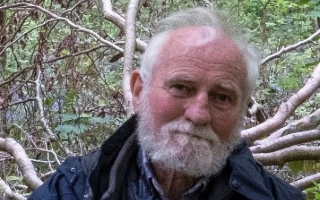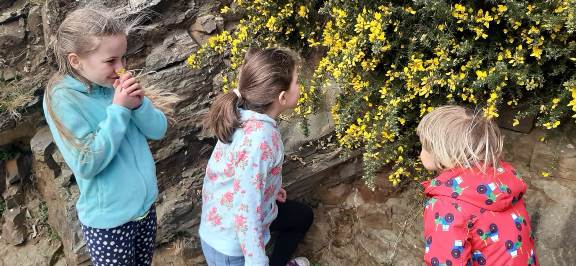Much research highlights the importance of engaging with nature for enhancing mental, emotional, and physical health.

Dr Paddy Madden is a former primary teacher, an author, a lecturer in social, environmental and scientific education, and a Heritage in School specialist since 1999. He visits schools regularly to engage children with nature.
—By Patrick Madden
It is surprising, therefore, to discover that connecting and engaging with the natural world are often omitted from the vast discourse on mental health and wellbeing.
For example, in an Irish context, there is little emphasis placed on the benefits of nature on well-being in the Department of Health (2013) report Healthy Ireland: A framework for inspired health and well-being 2013-2025. The only reference to nature and well-being in this report is on p. 49: “Amenities such as forest parks provide opportunities for recreation and our understanding of the environment thus supporting healthier lifestyles while contributing to our well-being”.
In the Well-Being in Primary Schools report (2015), jointly commissioned by the Departments of Health, Education and the HSE, there is a mention of ‘Plants and Trees’ in a description of the physical environment of schools (p.15). However, at no stage are there recommendations for engaging with these plants and trees. Moreover, in the ten activities for promoting well-being suggested in the report, there is no mention of engaging children with nature nearby or further afield.
Everyone Needs Nature Series
While these reports do not exhibit much excitement or enthusiasm about the benefits of nature for enhancing wellbeing, a recent one from the National Trust and the University of Derby, Noticing Nature: The First Report in the Everyone Needs Nature Series (2019) contrasts sharply with them in this regard.
The University of Derby report finds that noticing nature on a regular basis (daily if possible) has a significant impact on people’s ‘happiness and feeling life is worthwhile’, and also propels people to conserve it. Some ‘noticing nature’ activities outlined by the researchers are:
– listening to birdsong,
– observing birds, butterflies and bees,
– taking photos or drawing scenes from nature,
– smelling wildflowers,
– watching clouds,
– watching sunrise.
Sadly, they found that children were not regularly participating in the most important noticing nature activities: 70% to 90% never or infrequently participated.
If such a study were conducted in the Republic of Ireland would the results be significantly different? This writer thinks they would be worse because we have a poor record of nature education here for the past 100 years. See my research on this record here.
My own experience
I was lucky in that my 4th-6th class teacher, in the 3-teacher primary school which I attended in the fifties and early sixties, encouraged us to notice nature every day. He had no written learning objectives for this activity, we did not have to write down what we noticed, and there was no assessment of our learning. Each day, on our way to and from school, we collected specimens of plants, and every morning we deposited these on an old desk for the teacher to examine with us. His only resource for the oral lessons that followed was a seasonal coloured chart depicting plants in their habitats. As a result of these daily encounters with the local natural environment, many of us developed a lifelong interest in nature.
Certainly, none of the children in this school suffered from plant blindness, a term coined by J.H Wandersee and E.F.Schussler in 1999 who described the phenomenon as ‘the inability to see or notice the plants in one’s environment’.
I was privileged to spend seventeen years, from 2001 to 2017, as a student-teacher educator in SESE (Social, Environmental and Scientific Education). During those years it always amazed me how little the students knew about the natural world and how rarely they paid attention to what was unfolding on a seasonal basis. Seldom did I come across one who was knowledgeable about plants and animals. I can still see the incredulity etched on one student’s face one spring day when we were on the grounds of the College examining buds on the trees. When questioned why she looked so perplexed, she explained that she could not understand how she had reached the age of eighteen believing that all trees had the same type of buds!
US citizen R.M. Pyle, in the book Children and Nature: Psychological, Sociocultural, and Evolutionary Investigations (2002), was concerned about children’s ignorance concerning nature, or ‘nature illiteracy’, which leads to indifference about the environment. He argued that lack of close contact with, and appreciation of, our natural surroundings lead to ‘extinction of experience’ – the opposite of appreciation which leads to concern, and in turn leads to conservation. (This view concurs with those in the Noticing Nature Report described above). He viewed this phenomenon of disengagement, disaffection, ignorance and apathy as a real threat to the world where nobody is aware of what is becoming extinct, and nobody cares.
Journaling
One excellent method of encouraging children to notice nature using all their senses is through nature journaling, which is outlined in the downloadable book Opening the World through Nature Journaling (2012). Children observe, ask questions about, and document what they see on a nature journal.
The following is an example of nature journaling which I recently carried out with children:
When making a nature observation of a sycamore leaf in autumn, for example, I asked the students to say all their observations aloud after asking them these questions.
What do you notice?
I directed them to the shape, colour and texture, the veins, margin, apex, petiole and symmetry.
What questions have you got?
They asked: Why are there black spots on the leaf? Why is the green disappearing? Where did the lovely colours come from?
What does it remind you of?
They answered: It reminds me of a hand, a star, a crown…etc.
The children then sketched and annotated the leaf, an exercise that fosters accurate observation and the recording of data.

Children Noticing Nature
I have a dream
When the next curriculum is launched, children and their teachers will be encouraged to do short daily walkabouts around their school grounds to notice the natural happenings of the day.
Where is the wind coming from?
What do you notice about the clouds?
Has the bud on that tree changed from when you last saw it?
I wonder what bird is singing?
What is that bumblebee doing on the flower?
Has it a white tail, a red tail, a ginger tail, or a buff tail?
Assessment of the activity?
Leave it alone… there are some aspects of learning that cannot be assessed. But one thing is certain from this activity: the children and teacher will all feel better from noticing nature on their walkabout.